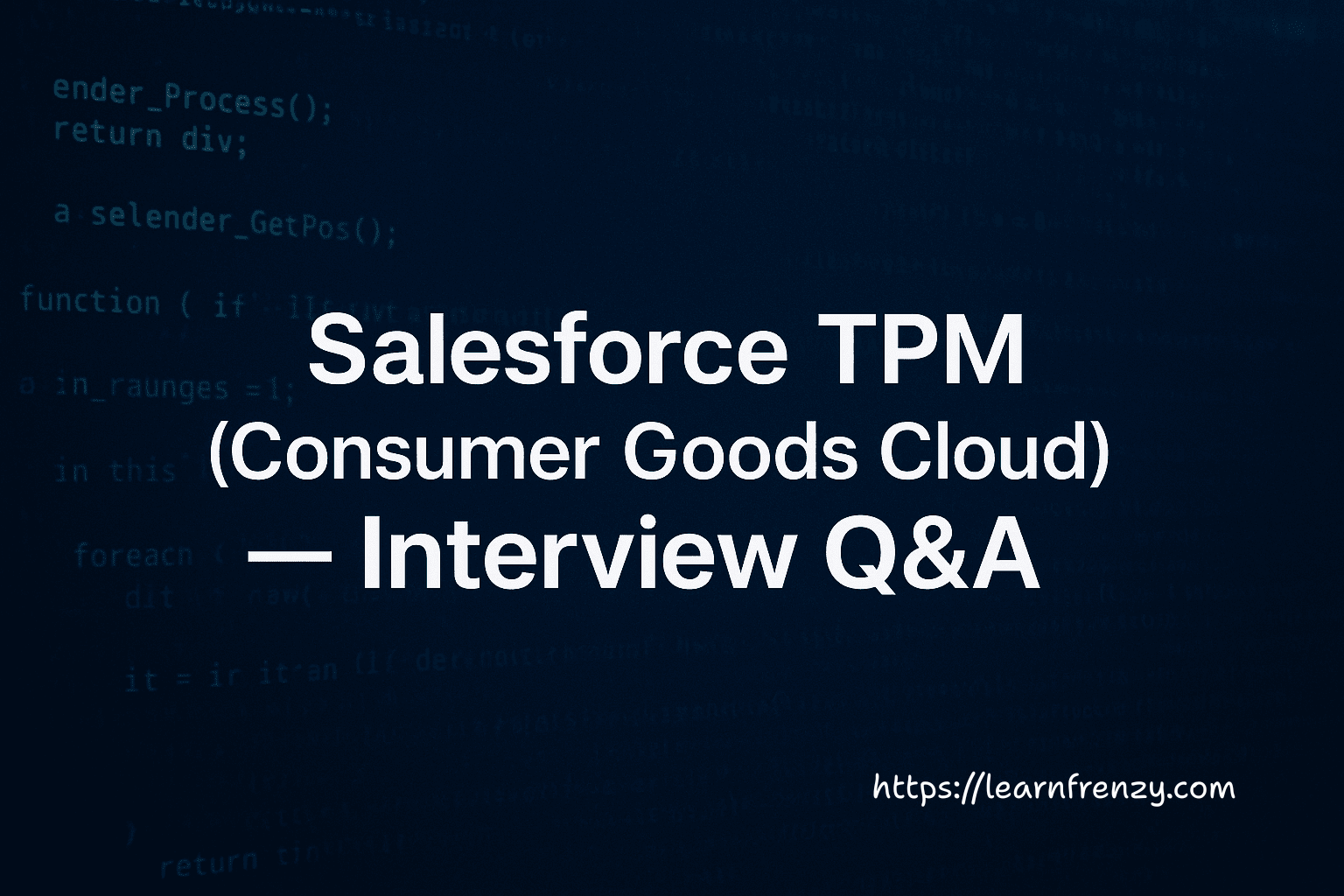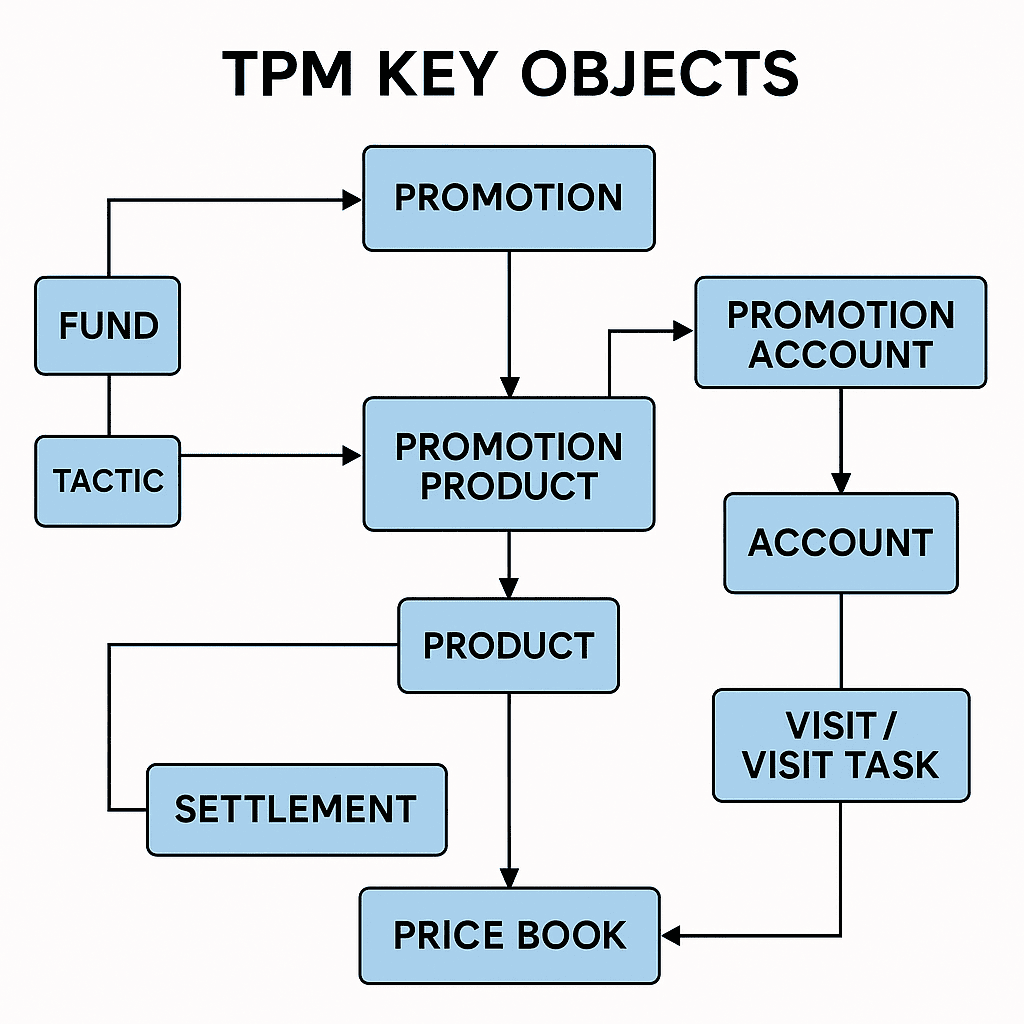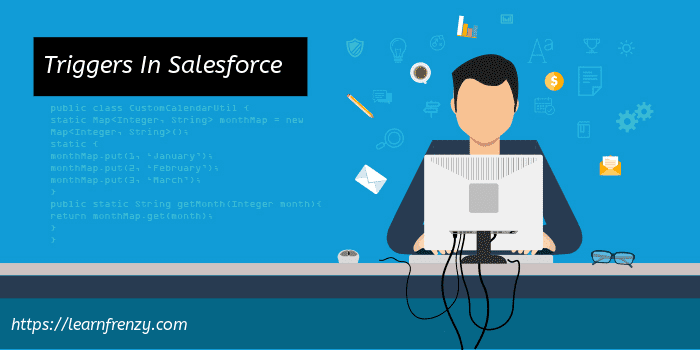Salesforce TPM (Consumer Goods Cloud) — Interview Q&A
So, you have an interview for a Salesforce TPM role focused on Consumer Goods Cloud. First off, congratulations! This isn't your average Salesforce position. A TPM in this space sits at a really special crossroads—where deep technology, strategic business vision, and flawless execution all have to meet.
But let's be honest, preparing for it can feel daunting. You're not just being tested on your knowledge of objects and workflows. They want to see how you think, how you lead, and how you connect complex technical challenges to real-world business goals, especially in the critical area of Trade Promotion Management (TPM).
Sound familiar? Then you're in the right place. Whether you're coming from a business analyst, functional consultant, or technical background, this guide is for you. We've broken down the key questions—and solid answers—that you're likely to face, covering the fundamentals, specific TPM scenarios, and the integrations you'll need to explain with confidence.
A Short “2-Minute TPM Explanation”
TPM in Consumer Goods Cloud helps companies plan, execute, and settle trade promotions with retailers. It starts with accounts and products, then budget is allocated through funds. A promotion is created, and each product is added with expected volume and price from the price book. Tactics define the discount or spend mechanics and draw from the fund.
During execution, field teams validate whether the promotion is active in stores. After the promotion ends, retailers submit claims or deductions. These are matched to the promotion through settlement. Reporting compares planned versus actual spend, uplift, and ROI. Overall, TPM gives full visibility from planning to financial settlement and helps improve future promotions.
![]() Interview Series
Interview Series
Let start the interview series on Salesforce TPM - CG Cloud (Between Interviewer & Interviewee).
1. What is Trade Promotion Management (TPM) in the context of Salesforce CG Cloud?
TPM in Salesforce’s Consumer Goods Cloud is a structured way for consumer goods companies to plan, manage, execute, and analyze trade promotions (discounts, displays, events) for their retail partners. These promotions drive in-store activity and help brands increase their market visibility and sales.
CG Cloud provides a unified platform for managing everything from planning (budget, tactics) to execution (transfer to retail) and post-promotion analysis, reducing manual effort and improving ROI.
In simple terms, it's about planning 'if we spend X dollars on a promotion, we expect to sell Y more units.'
Before a system like Salesforce CG Cloud, this was often done with spreadsheets and emails, which was messy and inefficient.
What Salesforce CG Cloud does is bring this entire process into one unified platform. It helps companies in three key stages:
- Plan & Budget: They can strategically plan their promotions for the year and allocate their budget across different retailers and products.
- Execute & Track: Once a plan is set, the system helps execute it, ensuring the right discounts are communicated to the right retailers without errors.
- Analyze & Learn: After the promotion, the platform connects the money spent with the actual sales data. This answers the critical question: 'Was this promotion profitable, and what was our return on investment (ROI)?'
![]() MIND IT !
MIND IT !
Final Interview-Ready Wrap-Up
So, in short, TPM (Trade Promotion Management) in CG Cloud is a Salesforce solution that helps consumer goods companies plan, execute, and track trade promotions with distributors and retailers. It provides visibility into budgets, claims, and performance metrics so companies can improve ROI on promotions.
2. Why do consumer goods companies need TPM?
Consumer goods companies need TPM because trade spend is one of their biggest costs, often 15–30% of total revenue. Without a structured system, it’s hard to control overspend, validate retailer claims, or understand which promotions actually worked.
Example:
A brand runs a “Buy 2 Get 1” offer with a retailer. TPM helps the team plan the promotion, track the discount cost, send the tactic to field reps, and later match the retailer’s claim to what was actually planned. This avoids paying more than expected and shows whether the promotion truly drove extra sales.
3. What are the main components of TPM in Salesforce CG Cloud?
The main components of TPM in Salesforce CG Cloud cover the full lifecycle of a promotion. It starts with planning and budgeting, where teams set goals and allocate funds. Then comes promotion creation and approval, where KAMs build the promotion and get it approved by finance or management.
Once approved, the promotion moves into execution and monitoring, which includes sending tactics to Retail Execution and tracking how the promotion performs in stores. After the promotion runs, retailers submit claims, so claims and settlements help validate what was actually executed and settle the payments.
Finally, post-event analysis looks at the results—ROI, sales lift, spend vs. plan, and other KPIs—so the company can learn what worked and improve future promotions.
![]() MIND IT !
MIND IT !
Final Interview-Ready Wrap-Up
The main components of TPM in Salesforce CG Cloud cover the full promotion lifecycle:
- Planning and Budgeting — Teams define goals, set budgets, and decide how funds will be used across customers and products.
- Promotion Creation and Approval — KAMs build the promotion, add tactics and products, and route it for approval to finance or management.
- Execution and Monitoring — Approved promotions are sent to Retail Execution, where field teams carry out in-store activities and track performance.
- Claims and Settlements — After the promotion ends, retailers submit claims. TPM helps validate what was executed and settle the payments against approved budgets.
- Post-Event Analysis — Teams review ROI, sales lift, spend vs. plan, and other KPIs to understand what worked and use those insights for future planning.
4. What are the main objects used in TPM and how do they relate?
Salesforce TPM in Consumer Goods Cloud relies on a set of standard CG Cloud and CRM objects that support planning, execution, settlement, and reporting.
Core objects:
- Account : Used to represent retailers, distributors, and customers. Most TPM processes, including promotions, tactics, and claims, are tied back to the Account record.
- Product / Product2 : Stores all product master data. Every promotion, tactic, and forecast references products through Product2 or Product-related linking objects.
- Promotion (cgcloud__Promotion__c) : This is the central TPM object. It captures the full promotion plan: dates, KPIs, budgets, funds, accounts, products, pay-out information, and execution details.
- Promotion Account (cgcloud__PromotionAccount__c) : A junction object between Promotion and Account. Critical when a promotion applies to multiple retail accounts or account groups.
- Promotion Products (cgcloud__PromotionProduct__c) : Links promotion with product combinations. Used for price mechanics, volume, and forecast inputs.
- Fund / Budget (cgcloud__Fund__c) : Stores budget allocation for a customer or brand. Promotions and tactics draw down from these funds.
- Tactic (cgcloud__PromotionTactic__c or custom "Tactic" object in some orgs) : Represents the individual activities inside a promotion. Tactics define execution steps like discounts, display fees, or P4P investments.
- Price Book / Price Book Entries : Used to fetch list prices, calculate discounts, and track spend mechanics inside tactics.
- Trade Spend / Settlement (cgcloud__Settlement__c) : Used for post-event settlement, deduction handling, and matching claims to planned spending.
- Visit / Visit Task (for retail execution) : Not core TPM, but part of execution and tracking shelf conditions. Works with promoting the tactic or in-store execution.
5. How a Promotion is Linked to Accounts and Products in Salesforce TPM
A Promotion doesn’t directly store multiple Accounts or Products inside the same object. Instead, Salesforce TPM uses two junction objects to manage these relationships:
1. Promotion <—> Account (via Promotion Account)
Object: cgcloud__PromotionAccount__c
This object links a Promotion to one or more Accounts.
Why it’s needed
Retailers often run the same promotion across:
- multiple stores
- multiple banners
- customer groups
- national / regional accounts
Relationship
Account <—— Promotion Account ——> Promotion
2. Promotion <—> Products (via Promotion Product)
Object: cgcloud__PromotionProduct__c
This links each product to the Promotion and stores all planning metrics.
Relationship
Product <—— Promotion Product ——> Promotion
What it stores
- product
- base volume
- uplift
- promoted volume
- discount %
- spend
- list price snapshot
- product group rollups
Final Interview-Ready Wrap-Up
A Promotion is linked to Accounts using the Promotion Account junction object, and to Products using the Promotion Product object. These junction objects allow one Promotion to support multiple Accounts and multiple Products, while storing account-level and product-level attributes like volume, uplift, pricing, and spend.







(0) Comments